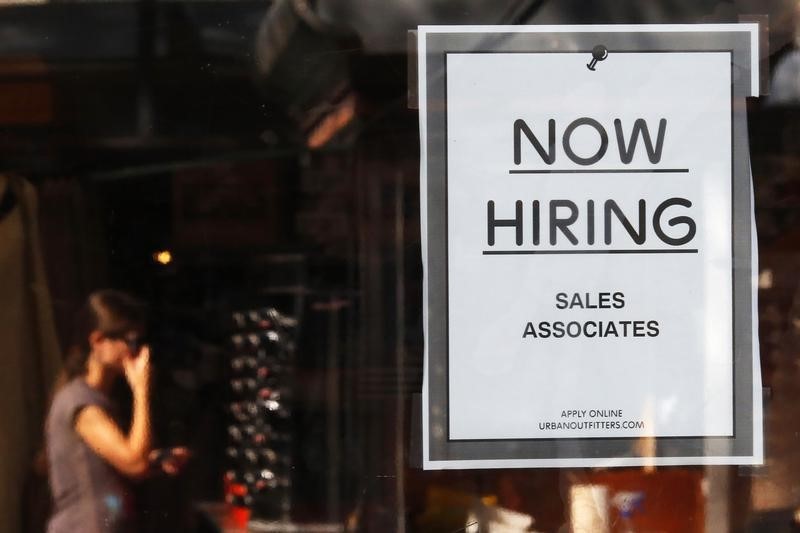(Bloomberg) -- U.S. unemployment is primed to fall significantly further and could drop below 3 percent for the first time since 1953, the year central bank chief Jerome Powell was born.
That’s according to economists at Goldman Sachs Group Inc (NYSE:GS)., JPMorgan Chase & Co (NYSE:JPM)., Deutsche Bank AG (DE:DBKGn) and Moody’s Analytics Inc. With an already solid economy set to receive a double dose of fiscal stimulus, they argue that a drop in joblessness from its 17-year low of 4.1 percent in February is all but inevitable.
And they say that a break below 3 percent is a distinct possibility -- even with the return of some workers to the labor force -- especially if Federal Reserve Chairman Powell doesn’t do more to slow the economy down.
“We have unemployment at 3.25 percent by the end of 2019,” Jan Hatzius, Goldman’s chief economist, said in an email. “A decline below 3 percent at some point is obviously possible.”
Such a drop would return unemployment to levels not seen in 65 years, when millions of Americans were out the labor force serving in the military during the Korean War. A job market that tight would be a boon for workers and for President Donald Trump.
But it would pose a quandary for monetary policy makers who are already beginning to worry about the risk of the economy overheating after Trump and Congress agreed to cut taxes and increase government spending.
To head it off, the central bank will raise interest rates four times each in 2018 and 2019, significantly more than Fed officials and investors currently expect, the Goldman, JPMorgan and Moody’s economists predicted. Peter Hooper, chief economist for Deutsche Bank Securities in New York, said there’s even a risk the Fed could end up increasing rates five times this year.
|
What Our Economists Say There is likely more slack in the labor market than the unemployment rate alone would otherwise suggest. The level of employment relative to the size of the population -- or the so-called employment rate -- has only retraced about 40 percent of the decline from the previous cycle’s peak. We currently expect three rate hikes this year and three hikes in 2019. -- Yelena Shulyatyeva and Carl Riccadonna, Bloomberg Economics |
“If the unemployment rate continues to decline on the current trajectory, it could fall to levels that have been rarely seen over the past five decades,” Fed Governor Lael Brainard said in a March 6 speech. “Historically, such episodes have tended to see elevated risks of imbalances, whether in the form of high inflation in earlier decades or of financial imbalances in recent decades.”
After beginning 2017 at 4.8 percent, joblessness has held at 4.1 percent for five straight months. It would have tumbled in February save for a big jump in labor force participation that Hatzius forecast won’t be repeated. Payrolls, meanwhile, grew 313,000, the most since 2016 and above the 90,000 to 120,000 range Fed officials reckon is sustainable in the long-run.
The steep drop in unemployment foreseen by the private economists stems from above-potential growth -- Moody’s Mark Zandi sees the economy expanding 2.9 percent this year versus potential of 1.75 percent -- and not from a contraction in the work force. Indeed, the forecasters all expect the labor force participation rate to hold roughly steady, as the re-entry of discouraged workers into the labor force is counterbalanced by the retirement of aging Baby Boomers.
Dartmouth College professor and former Fed official Andrew Levin said that may be too conservative. He sees room for labor force participation to rise, especially for prime age adults aged 25 to 54 -- a portion of the population that Powell highlighted in recent Congressional testimony.
“If the Fed doesn’t squelch the labor market, payrolls could indeed continue growing at 200,000 per month over the next couple of years without any substantial further decline in the unemployment rate,” Levin said in an email.
Fed policy makers have penciled in three interest rate increases for this year and about two next, according to the median projection of policy makers released in December. They’re widely expected to carry out the first of those hikes at their March 20-21 meeting, when they’ll also update their future plans and Powell will deliver his first press conference as chairman.
Stepped-up rate increases would take the central bank out of the business of merely removing stimulus from the economy to overtly acting to slow growth down with a restrictive policy stance, said Michael Feroli, chief U.S. economist for JPMorgan.
Eight quarter percentage-point rate increases would leave the central bank’s target for the overnight federal funds rate at 3.25 to 3.5 percent at the end of 2019. That would be above the 2.8 percent rate Fed officials consider as the long-run neutral rate that neither spurs nor retards growth.
A more aggressive Fed would run the risk of roiling financial markets -- Hatzius says investors are only pricing in four or five hikes in 2018-2019 -- and raise the chances of a recession.
Even with such rate increases, unemployment will still settle well below Fed officials’ 4.6 percent estimate of its long-run sustainable level -- at 3.5 percent under Zandi’s baseline, 3.3 percent under Feroli’s and 3.2 percent for Hooper.
Powell told lawmakers earlier this month that some further strengthening of the labor market “can take place without causing inflation” even though he judged the U.S. is “very close to full employment.”
He added, though: “We don’t want to run too far past the natural rate of unemployment.”
Trump and Congress “threw gasoline on the economy” with their tax cuts and spending increases, said Timothy Adams, president of the Washington-based Institute of International Finance. “At some point, the Fed may have to become really aggressive” to rein it in.
